GEOGRAPHY OF THE USA.
The United States of America is the most economically developed country in the world. By
the size of the territory, this state ranks fourth in the world.
Its area is 9364 thousand square meters. km. It is a 50-state republic and
Federal District of Columbia (the territory of the capital of the country - Washington). 48
states are located compactly, 2 separately: Alaska, bought from the royal
the Russian government in 1869, and the Hawaiian Islands.
The economic and geographical position of the United States is very favorable: a wide front
sea borders in the west and east (12 thousand km.), beautiful harbors... By
state systems of the United States - a federal republic, each state has
its constitution, its legislative and executive bodies authorities,
an elected governor; and symbolism.
The development of huge
wealth. Today, the United States ranks first in western world by reserves
coal, uranium, the second - in terms of gas, copper, zinc reserves, iron ore... Many
deposits are depleted. There is a lack of alloying metal ores (chromium, nickel,
cobalt).
The vast territory of the United States is home to about 250 million people, which
is the third largest in the world. Modern Americans besides
indigenous population (1% of Indians, Eskimos, Aleuts, Hawaiians), includes
themselves and people from different countries of the world (75%). An integral part of
American nation are blacks (12%), whose ancestors were brought from
Africa for plantation work. Great impact on the population
has immigration, an annual influx, which is now about 1
million people. In the second half of the 20th century, immigration from Europe significantly
decreased, but the number of immigrants from Asia increased, and especially
from Latin America.
The US industry is distinguished by a high level of production and
territorial concentration. All existing industries are represented in it,
focused on the release of both mass and serial products.
US HISTORY IN THE FIRST HALF OF THE XX CENTURY.
The United States entered the First World War late, and its casualties were
are small. During the First World War, industrial production made
big race. The financial position of the United States in the world has also changed. Of the debtor
In Europe, they have become an international creditor.
A major shift took place in the development of the material and technical base
American capitalism. Large corporations have become the initiators of development
mass production. At the forefront of technological progress were:
automotive, chemical, electrical industry, manufacturing
household appliances. Conveyor lines pioneered by Henry Ford in 1914
at an automobile plant in Michigan, became the personification of the technical and
technological restructuring of industrial production. Flow lines
rationalization and intensification began to be introduced in the production of household
Impressive Technological Advances and Rapid Growth
production gave rise to a new term "prosperity" ("prosperity") and
illusory belief in crisis-free development.
However, in this development, the problem of sales became more and more acute.
products due to low purchasing power. It was "Achilles'
heel "of American prosperity. Few entrepreneurs understood this.
Henry Ford ordered, "Reduce prices to purchasing power," and
the new method reduced the price of the Model T to $ 290.
Ford has become a national hero. By 1925, Ford had achieved the admission of 9000 cars into
day. Since 1927, Ford put into production the Model A.
Ford forbade talking, singing, smoking, whistling while working.
One critic remarked that the only thing a worker had to do was
“Put nut 14 on bolt 142 and repeat, repeat, repeat until
hands did not start to shake, and legs tremble. " But Henry Ford paid his
workers more than other entrepreneurs.
At that time, a new formula was invented “advertising + credit =
prosperity forever. " But selling on credit is debt. Endlessly this
could not continue. Meanwhile, wages grew slower than the growth rate
production and inflation.
American prosperity had a beautiful facade: the development of mass
culture. Cinema entered the life of the layman, and with it the idols of the cinema Mary
Pickford, Charles Chaplin. Daily newspapers were published in large numbers. Almost
a radio appeared in every house. One in five Americans owned a car.
Cinemas, stadiums for mass sports events (football,
hockey, baseball, etc.). Jazz music is gaining wide popularity,
fashionable new dances, clothes and hairstyles were democratized. New technique
changed the conditions of life.
The frantic rhythm of economic development, personifying the material
progress, the latest achievements of science and technology, transformation of everyday life
combined in the United States with the growth of conservatism and militant individualism.
Business has achieved the abolition of a number of laws that infringed the rights of the owner, and
wartime regulations. Entrepreneurs were annoyed by the incessant
strikes and demands of trade unions. Business America resisted
implementation of legislation similar to social reforms in European
countries. The defensive reaction to revolutionary events in Europe gave rise to
campaigns against the "red threat".
Conservatism in the United States was fenced off from revolutionary events in Europe and
growth in their own country of social and racial conflicts.
The Ku Klux Klan has become more active. The number of members in this racist
organization has grown in the early 20s. 10 times and reached 5 million people.
Racial discrimination has become significant, especially in the South.
School teacher Scops was convicted of teaching the theory of evolution to C.
Darwin ("monkey process"). Italian immigrant workers Sacco and
Vanzetti was electrocuted on trumped-up charges of
the murder of a factory guard.
The bacchanalia of profit and stock speculation had a different side: the country
were shaken by corruption scandals in a number of members of Congress and
government. Underground business flourished, especially illegal
production and sale of alcoholic beverages (in the USA from 1920 to 1923.
the "dry law" was in effect). In fast-growing cities and in large
whole gangster syndicates appeared in industrial centers. For example,
gangster syndicate Al Capone reigned supreme in Chicago while his
the chapter was not hid in 1931 in prison for "violation of the tax
legislation ". Their al capone appeared in every more or less in
significant city.
In the 20s. USA - a land of contrasts: excellent technical
innovation, demonstration of the enormous possibilities of science and technology, but also
and the accumulation of internal contradictions, social contrasts of wealth and
poverty of the bulk of the population. The speculative nature of the economic
prosperity gave rise in the ruling circles of the country to the illusion of inviolability
the existing order. Even during the boom years, 60% of the US population
did not have a minimum of means of subsistence. Elected President 1928
USA famous Republican politician Herbert Hoover promised the Americans
end poverty. His motto “Chicken - in each
pan! ".
Against this background, an unexpected, stunning event was the fall in the exchange rate
shares on the New York Stock Exchange in October 1923 (for three weeks the cost
shares fell 40%). This is how the world began economic crisis 1929-1933
biennium It has had the most dire consequences for the American economy.
As a result of the crisis, more than 5 thousand banks went bankrupt. Millions
Americans have lost all their savings. For 3 years industrial
production decreased by half, the volume of foreign trade - by three times. V
rates decreased twice wages... By the spring of 1933 in the country
there were up to 17 million unemployed. On the outskirts of big cities have grown
villages of shacks, where people huddled who lost their jobs and homes. Settlements
nicknamed "Hooverwils". Due to falling prices for agricultural products
hundreds of thousands of farmers were ruined.
During the years of crisis, workers rarely came up with their demands, so
how they were afraid of losing their job. But the unemployed had nothing to lose, they
fought for survival. The National Council was formed in Chicago in the summer of 1930
unemployed. Mass demonstrations and "hunger campaigns" began, which
were held in Washington in 1931-1932.
Here is how historians tell about these events: “In the summer of 1932.
Washington paralyzed fear: veterans of the first gathered in the capital of the country
World War II, requiring an increase in benefits. There were 25 thousand of them,
Army Chief of Staff, General D. MacArthur, expelled the veterans from
cities. The soldiers stormed the wretched village built by the veterans in
suburb of the capital Anacostia Flats, and burned it, several people
perished. The veterans returned home, spreading fiery hatred to
the government, which fully rewarded them for their service in 1917-1918.
In this situation, in the fall of 1932, he won the presidential elections
Democratic candidate Franklin Roosevelt (1882-1945). My
Roosevelt called the presidential policy a new course. Its main idea
was the introduction of a "constitutional economic order". New
the administration began by strengthening the country's banking system through
support of large banks, concentration of the entire US gold reserve,
devaluation of the dollar. One of the first laws to be passed was to regulate
agriculture (AAA-Agricultural Adjustment Act).
A special role was assigned to the law on the restoration of national
industry (NIRA - National Industry Recovery Act). It envisaged
the introduction of codes of "fair competition" that established
working hours and minimum wages. Companies,
those who signed such codes received government support.
The state tried to regulate relations between entrepreneurs and
workers. It supported the rights of trade unions, but at the same time left for
the role of arbiter in conflicts between workers and business owners.
To reduce unemployment, public works programs were implemented - from
cleaning streets, before the construction of roads and other objects. Their motto was:
"Not corrupting benefits, but healthy work." Received special support
Resource Conservation Civil Corps, recruiting youth to work. Per
More than 3 million Americans have gone through it in 10 years. Active intervention
the state into the economy, the regulation of production were aimed at
to get the country out of the depression. But the New Deal event caused
Americans have a contradictory attitude. Many saw in him an attempt on
The "holy of holies" of the American way of life is free enterprise. V
newspapers called Rooseveld red, some claimed that he “opened the way
to communism, ”others argued that he was a fascist. He himself explained the motives
their actions like this: “We are against the revolution. So we are waging a war against
conditions causing revolution - inequality and injustice ”.
In the mid-30s. the action of the main acts of the "new course" (including
including NIRA) was stopped by a decision of the US Supreme Court. However on
elections in 1936 F. Roosevelt won by a large majority of votes and again
became president.
History of the United States in the second half of the 20th century.
The United States withdrew from the Second World War, significantly strengthening its
political and economic influence in the world. Territory of the United States, as opposed to
European countries was not a battlefield; much smaller than
other participants in the war, there were human losses (they amounted to about 300 thousand.
human). By supplying arms and food to the allies, the United States supported its
industry and agriculture and at the same time became a creditor
all over the world. If in 1937 the share of the USA in industrial production was
called the capitalist world was 41.4%, then in 1946 - 59.1%.
With atomic weapons at their disposal, American leaders
used it to show strength, hoping it would also help
them to dictate their terms when the device post-war world... Late 1945
Mr. President of the United States H. Truman said: “Whether we want it or not, we
must acknowledge that the victory we have won has entrusted the American
the people are the burden of responsibility for the further leadership of the world. "
In preparation for this mission, the administration took up
strengthening the military sphere. In 1947 they were reorganized and subordinated
unified management of all military departments, for the leadership of which was introduced
the post of Minister of Defense, the National Security Council was created under
the president. At the same time, the CIA (Central
Intelligence Directorate). At the same time, the network began to unfold
US military bases and facilities in various regions of the world: in Europe (in
NATO member states), on Far East and in the Pacific
ocean, Latin America and the Caribbean, the Middle
East, etc.
In the 80s. The United States had almost 1,600 military bases and facilities on the territory
34 states with over 500 thousand American troops.
So the economic leadership was supplemented by a military presence in all parts
Political life in the United States reaches its peak once every four years
activity: Americans elect the president of the country. Main candidates
are nominated by two parties: the Democratic and the Republican. Is not
the only but most influential party in the country.
Although the Democratic and Republican parties arose in the 19th
century, they differ from many traditional political associations. One
of the features is the broad social base of both parties. About them
it is impossible to say how often it is done in relation to well-known European
parties, that these are organizations of the big or petty bourgeoisie, workers or
peasantry. Both parties are supported by people of the most diverse
social status.
Both have no formal membership (with tickets, membership fees and
etc.), the centralized structure of party organizations, long-term
political programs. These are the parties of voters. Their main task is to fight
for power during the elections. National Congresses of Democrats and
Republicans are usually convened in a presidential election year to
to approve the election program and candidates for the posts of President and Vice-
president. At the same time, no "confusion and vacillation" is allowed, the party
nominates only one candidate for each post. Big
the role in the outcome of the struggle is played by the personality of the nominated candidate, voters
Therefore, for example, in 1948, both parties, according to the definition of historians,
“Courted” D. Eisenhower, who became famous during the war years,
persuading him to become president. General, who previously did not support at all
none of the parties refused. Only in 1952 he was persuaded to his side.
Republicans, who had been in opposition for 20 years, and Eisenhower
won the election by a huge majority.
With both parties serving primarily as part of the electoral
mechanism and reflect in their programs the political situation
by the time of the elections, their positions on a number of issues differ markedly.
Democrats, who have always been supported by broad strata of the population, in the twentieth century.
often acted as supporters of economic regulation, reforms, flexible
social policy. Republicans who traditionally held more than
conservative positions, defended the ideals of individualism, private
entrepreneurship, defended a free market economy.
The coming to power of representatives of one or another party determined
changes in political course in the United States. At the end of World War II
During the war, the Democrats were in power (G. Truman), in 1953-1960. -
Republicans (D. Eisenhower), 1961-1968 - Democrats (J. Kennedy, L.
Johnson), in 1969-1976. - Republicans (R. Nixon, J. Ford), in 1977-
1980s - Democrats (J. Carter), 1981-1992 - Republicans (R.
Reagan, D. Bush), in 1992-2000. - Democrats (W. Clinton). Since 2001
US President - Republican George W. Bush.
population, not only do not reduce, but, on the contrary, exacerbates the struggle for
"Average voter". All means are used. During the pre-election
the 1972 campaign, Republican agents were arrested and infiltrated
apartment of the Democratic Party in Washington (it was located in the complex
buildings called Watergate). A year later, this episode became public
publicity, an investigation has begun. The Watergate Case and a Series of Others
revelations forced the Republican President R. Nixon to leave in 1974 in
resign.
Distinctive feature of the American political system is
that significant powers of the President of the country, heading
executive power, are balanced by a system of "checks and balances".
This means that the legislature (Congress) and the judiciary
(The Supreme Court) have the option of the constitutionally established order
suspend or cancel the implementation of presidential decisions, nominate their
initiatives.
An example of such a situation was the adoption in 1947 under the president of
Democrat H. Truman is far from the democratic Taft-Hartley law,
which limited the political and strike activities of trade unions, deprived
their number of rights won in the 30s. In the same year, the persecution began
representatives of individual political parties and public organizations,
government officials and even Hollywood figures accused of
"Anti-American", "subversive" activities. Primarily to
people with communist, anti-fascist
beliefs. This course was continued on a larger scale under D.
Eisenhower.
In 1953-1954. over 8 were dismissed from government agencies
thousand "suspicious" employees. Rampant anti-communist campaign
deployed by Senator J. McCarthy, who saw enemies and traitors everywhere
nation. On his initiative, a high-profile investigation of “espionage in
army ", the sessions of the tribunal were broadcast on television every day during
months. Senator's supporters called for the burning of "inappropriate" books.
McCarthyism became the personification of an extremely reactionary, anti-democratic
politics. The Senate was forced to convict McCarthy for "conduct contrary to
Senate Ethics ".
A special place in the history of the United States in the second half of the 20th century was occupied by presidents,
whose activities marked a turn in the political life of the country. One of
they were J. Kennedy.
After coming to power, Kennedy proclaimed a policy of "new frontiers". Speech
was about strengthening the internal position and international positions of the United States. One
of the main tasks was the acceleration of economic growth, the state
at the same time it controlled the level of prices and wages. In the sphere
industrial relations were supported by the idea of "class cooperation".
Considering that as a result of the automation of production during that period, the
unemployment, the government has increased spending on assistance to the unemployed, and
supported retraining and additional training programs for workers.
J. Kennedy attached particular importance to improving the average and
higher education. he said: “We are going to double the number of
in college students. This means that we need to build
in 10 years as many buildings for colleges as we have built in the past
160 years ... We cannot support our industrial, military and social
power without having well-educated citizens. In this regard, should play
the role of the federal government. " A significant role in the advancement of such tasks
played scientific and technical advances USSR at that time. One of
the creators of the American nuclear bomb E. Teller emphasized: “Progress
Russia has aroused admiration for communist methods ... the Soviet Union won
a great battle in school classes ... I think that in 10 years Russia
will be recognized as a leader in the field of science ... If we do not start
act immediately to educate our children by preparing them
to the tasks of restoring the scientific leadership of the United States, I have no
there is no doubt that by the end of the century the world will be rebuilt according to plans
communists, and not in accordance with our ideas. "
“New frontiers” were also outlined in foreign policy. Kennedy exposed
criticism of the doctrine of "massive retaliation" of the communist regimes,
"Liberation of Eastern Europe". But he was not going to give up the military
political superiority of the United States in the world. It had to be provided
the country's powerful military capabilities and a flexible response policy. At
Kennedy's US military spending reached $ 60 billion a year, while before
this under D. Eisenhower, who was a professional military man, they
amounted to 40 billion dollars a year. The atmosphere of a threat was escalated in the country
atomic attack from the USSR, in 1961 the government proposed
to start building shelters everywhere (including individual
for each family). The matter was not limited to defense measures. V
April 1961, an attempt was made by the CIA to armed
the invasion of 1,400 American mercenaries into Cuba. It ended in complete
failure.
In October 1962, the so-called Cuban Missile Crisis took place. He
arose due to the deployment in Cuba of Soviet missiles and bombers of medium
radius of action. Kennedy in an ultimatum, threatening to use
thermonuclear weapons, demanded that the Soviet leadership remove the missiles.
The world was on the brink of war. In this situation, two leaders, J. Kennedy and N.
S. Khrushchev took one step away from the brink of the abyss and settled the conflict by
negotiations. Soviet missiles were removed from Cuba.
Apparently, this incident became some lesson. Soon J. Kennedy
said in one of his speeches: “Let's reconsider our position in
the attitude of the Soviet Union ... It is not at all required that the neighbors love each other
friend, it is only required that they be mutually tolerant. " In August 1963
the representative of the American government signed in Moscow
international treaties banning nuclear weapons tests in the atmosphere,
space, under water. The emerging balance in the positions of the president
was not supported by all Americans. Extreme right extremist
groups (Ku Klux Klan, John Birch Society, etc.)
betrayal of national interests.
President J. Kennedy was killed (a few days later he was shot and
murderer L. Oswald). Investigations into the circumstances surrounding the Kennedy assassination have never been
gave a clear and convincing conclusion whether it was the work of a fanatic
loners or the result of a conspiracy.
Kennedy's successor to the presidency of Democrat L. Johnson, acting
under the slogan of creating a "great society" in the United States, held a number of social
reforms that have improved the lives of the poorest. At the same time, in 1965
he sent American troops to Vietnam. By the beginning of 1969 there were
about 550 thousand US military personnel. A brutal war of annihilation that
led American troops for almost 10 years against the Vietnamese
people ended in the biggest defeat in US history. The President, with
whose name was associated with another turn in the post-war history of the United States, became
R. Reagan.
R. Reagan was elected president of the country in 1980 (in 1984.
re-elected for a second term). His policy was called "conservative
revolution ”. He abandoned the one adopted by the Democratic presidents since
the time of F. Roosevelt, the tactics of state regulation of the economy,
social compromise. Reagan's course was on the rise
production by enhancing entrepreneurship in a free
market economy. For this, a reduction in income taxes was carried out.
(from which large corporations benefited in the first place), reductions
social spending on education, medicine, pensions, etc.
(in 1981-1984 their share in the state budget fell from 53.4% to
Like all neoconservatives, R. Reagan advocated strengthening the military
positions of the United States in the world. His administration put forward the task of modernization
strategic weapons of the United States, and then - "strategic defense
initiative ”(SDI), called the“ Star Wars ”program. The share of the military
expenditures in the state budget increased from 23% in 1980 to 27% in 1985
However, the development of international relations is determined by the positions of many
countries. It so happened that the course of the neoconservatives to exacerbate
confrontation with The Soviet Union from the second half of the 80s. became
change. The decisive role in this was played by the
the concept of "new political thinking" in international relations. R
Reagan, who previously called the Soviet country an "evil empire", as a result
a series of meetings and negotiations with the President of the USSR M.S.Gorbachev agreed
conclude an agreement on the destruction by both powers of part of their
nuclear weapons. The turn in Soviet-American relations that began
during that period, later affected the relations between the Russian
Federation and USA.
In the post-war decades, a lot has been done in the United States in order to
to strengthen the economic and military power of the country, its position in the world, to preserve
internal stability, improve the living standards of the population. And yet at
many citizens of this country have had and still have problems that encourage social
protest, fight for their rights. In different periods,
various problems and, accordingly, movement. When in the second half of the 40s
biennium the Taft-Hartley Act was passed, significantly restricting the rights
trade unions, the responses to it were massive workers' demonstrations. They
held thousands of demonstrations and strikes. In total in 1947-1948. v
4 million 130 thousand people took part in the strikes.
In the 50s. in many states the struggle of blacks unfolded
Americans against racial discrimination (inequality), for civil
rights. At that time in the south of the country there was a segregation (division) of the white
and the black population: children studied separately, places were specially designated
"For whites" and "for blacks" in transport, in the service sector. In this situation
the attention of all America was attracted by the events of 1955-1956. in Montgomery
(state of Alabama). Here, black residents boycotted the city
transport, in which there were separate seats "for blacks" and "for whites."
Since then, similar campaigns have been carried out in many southern states.
A new wave of the struggle of the black population of America for civil rights
rose in the middle of the 60s. At this time, it was no longer possible to keep her in
within the campaign of civil disobedience, the supporters of which were M.L.
King. Riots in one of the suburbs inhabited by black residents
Los Angeles in the summer of 1965 resulted in clashes with the police, destruction
houses, shops, destruction of cars, etc. 34 people were killed,
899 were wounded, 4000 were arrested. Material damage amounted to 45 million.
dollars. During this period, an organization of militants "Black Panthers" emerged,
calling for an armed struggle against whites. In 1966, the excitement of black
population occurred in 42 cities, in 1967 - in 114.
In the second half of the 60s. significant scope in the United States has acquired
movement to end the Vietnam war, the main participant of which
has become student youth. The protest against the war was expressed in refusal
conscripts to go to the army, public destruction of draft summons. In autumn
1967 50 thousand people demonstrated in front of the building of the military department -
The Pentagon. Along with anti-war sentiments, dissatisfaction and
internal politics, groups of young people have emerged calling themselves “new
left ". The administration felt that the situation was getting out of hand.
control. To disperse the demonstration, detachments of the national
guards, army airborne units.
In the spring of 1968, the US government first announced its readiness
enter into negotiations with representatives of North Vietnam. L. Johnson, in
whose years as President of the United States got involved in this inglorious
war, announced the decision not to participate in the next presidential elections
as a candidate. Such an outcome of events was led as a defeat
US troops in Vietnam and anti-war demonstrations inside
In general, social performances and movements in the United States in the second half of the XX
centuries have shown that high level development, wealth and democratic
the foundations of society by themselves do not eliminate all life contradictions and
problems of people. When talking about ideals and principles, it is important to correlate each time
them with practical actions.
Bibliography:
World history - E. I. Koreneva.
Recent history of the XX century - L. N. Aleksashkina
Recent history - A.O. Soroko-Tsyupa
Sites on the Internet.
September 6th, 2012Original taken from radulova in The Daily Life of Americans in the 1940s
Shop windows in Salem, Illinois in 1940. Three pounds of sausage - 25 cents. The median income of Americans in 1940 is said to have been about $ 515 a year, or about 25 cents an hour. That is, if you worked for an hour, you could buy 1.4 kg of sausage for a family. The median household income in America today is about $ 48,000 a year. Most households have two workers, unlike in the 1940s, so the average per capita income is probably about $ 24,000, or about $ 12 an hour. The sausage costs about $ 4 a pound. That is, even today the average American can buy 3 pounds (1.4 kg) of sausage in one hour of work. Just like 72 years ago... This is stability.
Family dinner. 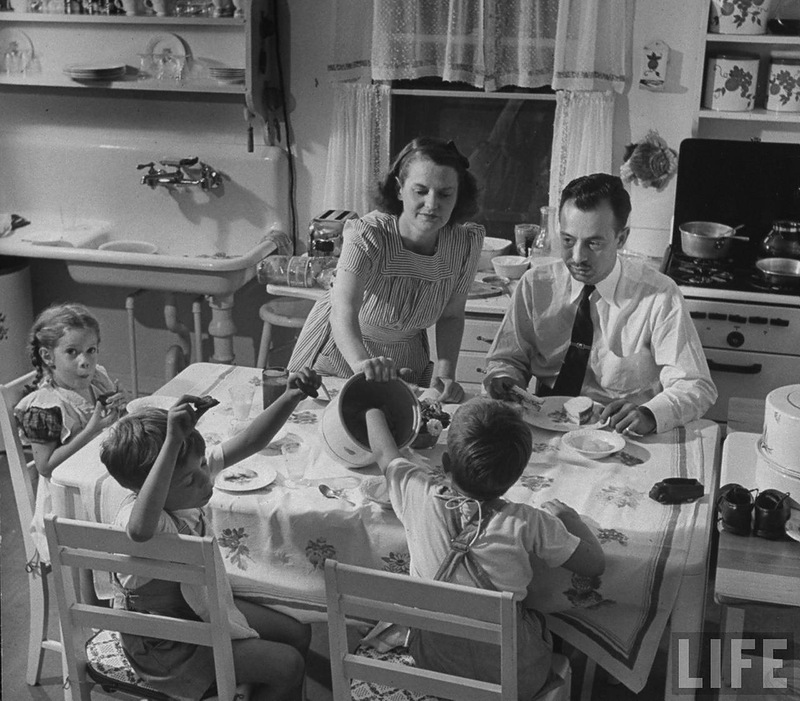


Tractor in the field. State of Iowa, 1940. 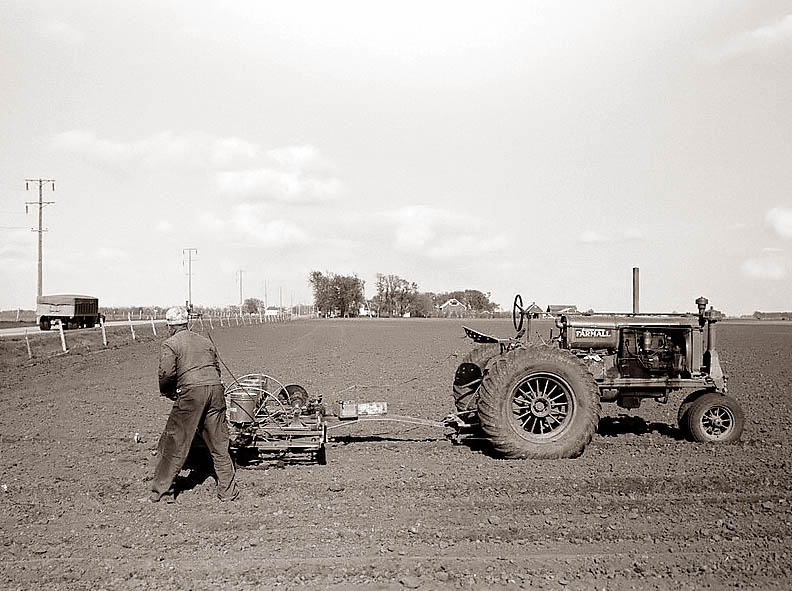
Father and daughter are listening to the radio. California, 1940. 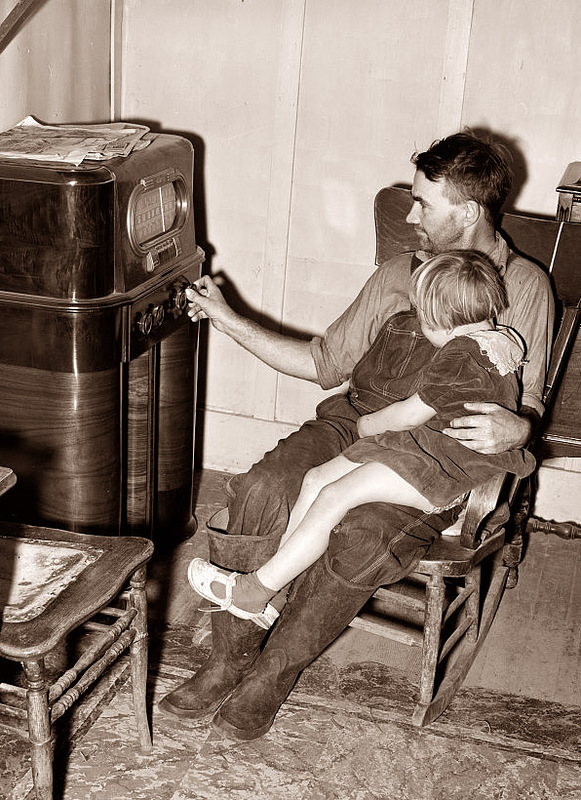
Kitchen. In the 1940s, freezers had already appeared in refrigerators, and stand-alone freezers were also sold. By the way, by 1962, refrigerators had: in the USA - 98.3% of families, in Italy - 20%, in the USSR - 5.3% of families.
Very small refrigerator. 
1940, pub, Texas. Cowboy hats were commonly worn by farmers. 
Blanks for the winter, 1940. 
1940
1940
A woman plays the piano for a group of people. Date taken: 1940. Photographer: George Strock 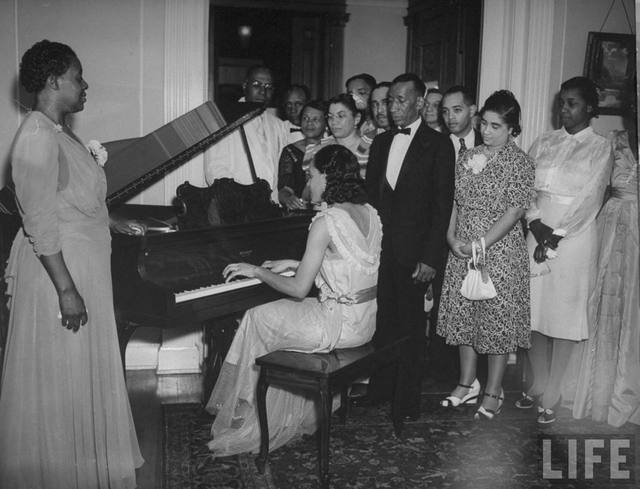
Shops in Chicago, 1940. The US economy in 1940 gradually emerged from the Great Depression. By the way, the Great Depression most strongly affected the United States, Canada, Great Britain, Germany and France, and was felt in other states as well. But in Russian, the term "Great Depression" is often used only in relation to the economic crisis in the United States. In parallel, the term world economic crisis is used. 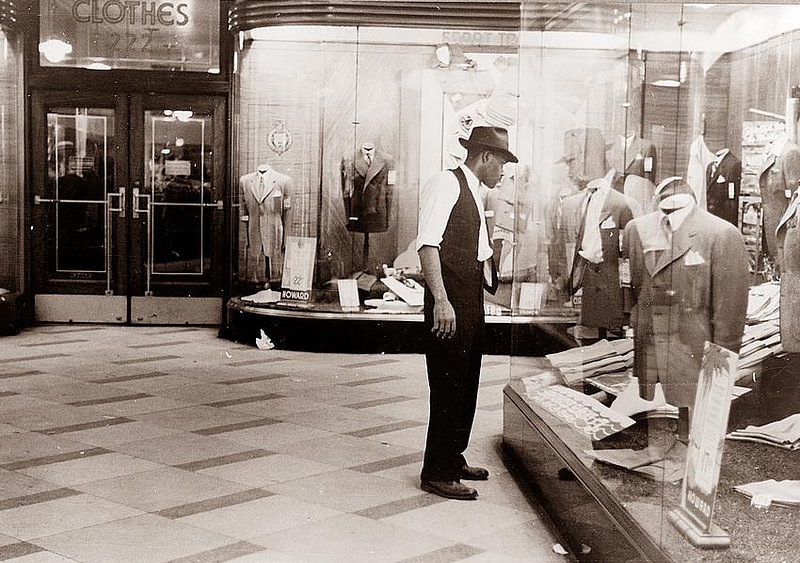
1940, family photo. 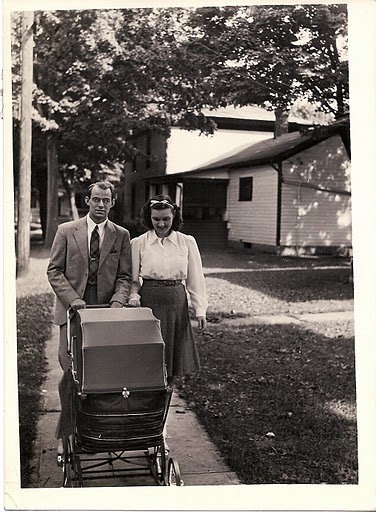
Rural America, at the fair. Family car, 1940, New Mexico. 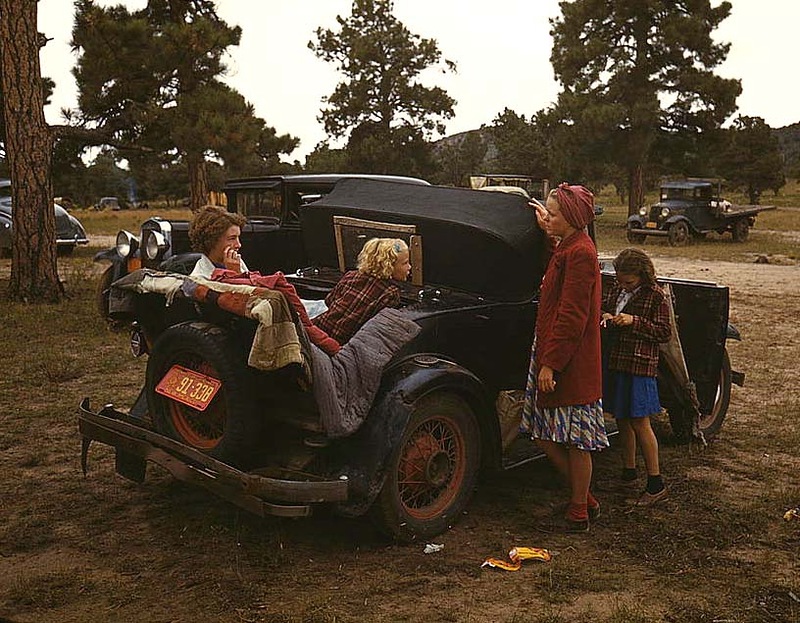
At the same fair. Father and daughter. 
The same village fair, 1940. 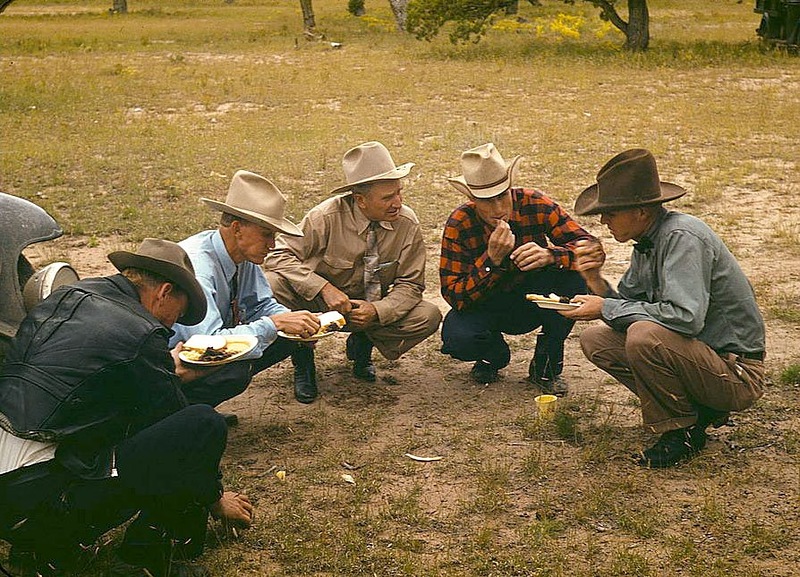
Beach, 1941. 
Photo: Charles Cushman. 


Children play in Chicago, Illinois, 1941. 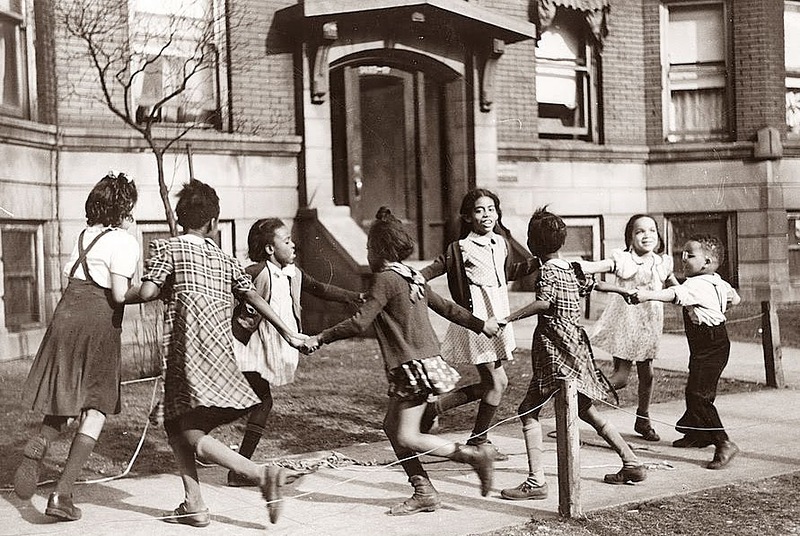
Easter Sunday 1941 in Chicago. The boy dressed up, goes to church. 
Boys in their father's pickup truck, 1941. 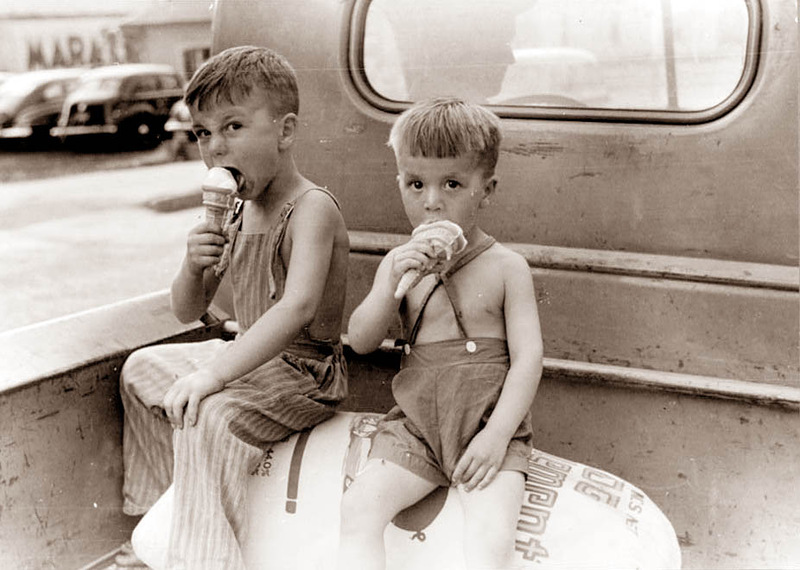
Children Playing War, Washington, 1941. 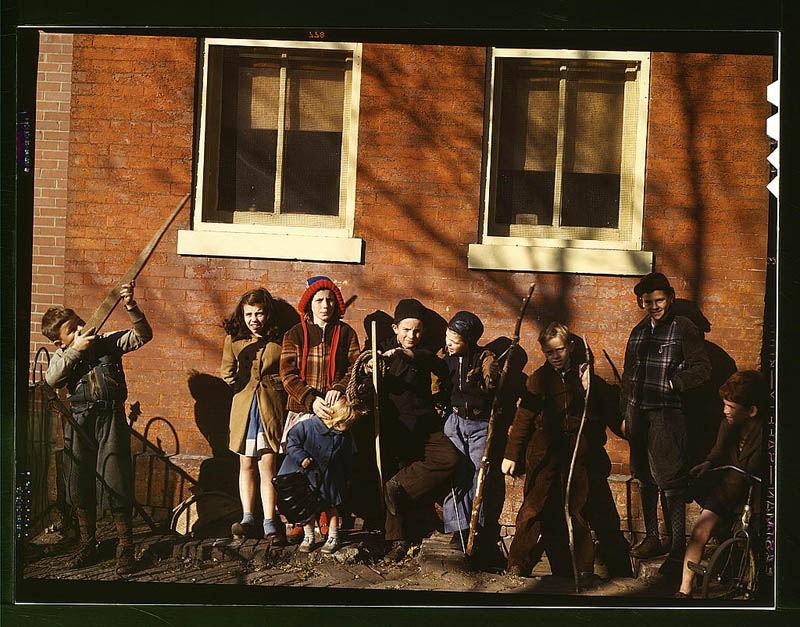
Small shops, 1942, Nebraska. 
New York, 1942. 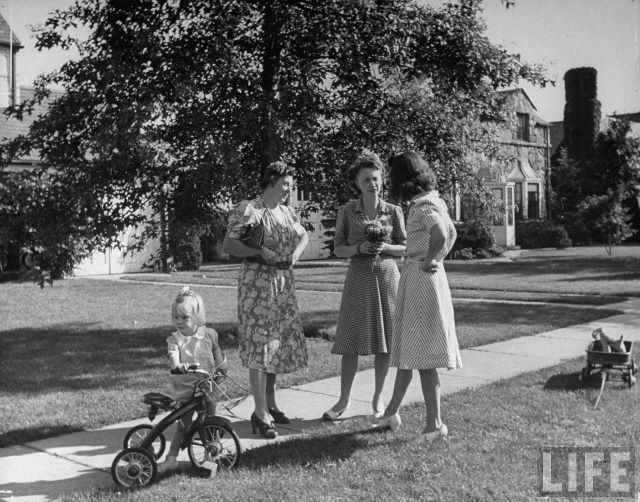
Ice cream parlor, 1942. 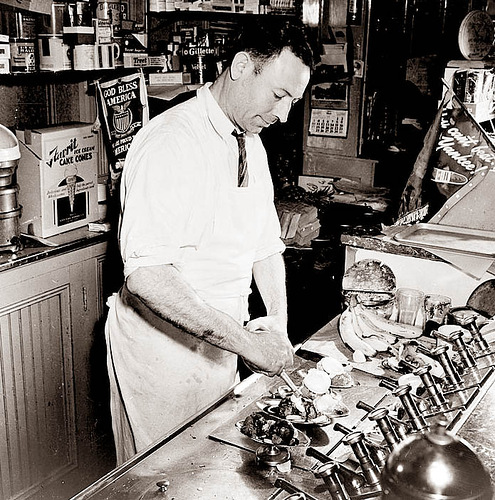
A woman is assembling the engine of a B-25 bomber. The United States has been involved in World War II since 1941. In June 1944, the Western Front in Europe was opened. The United States lost 418,000 people in World War II. America began helping the Soviet Union in 1941. 
Lend-Lease is a state program under which the United States transferred to its allies in World War II ammunition, equipment, food and strategic raw materials, including oil products. 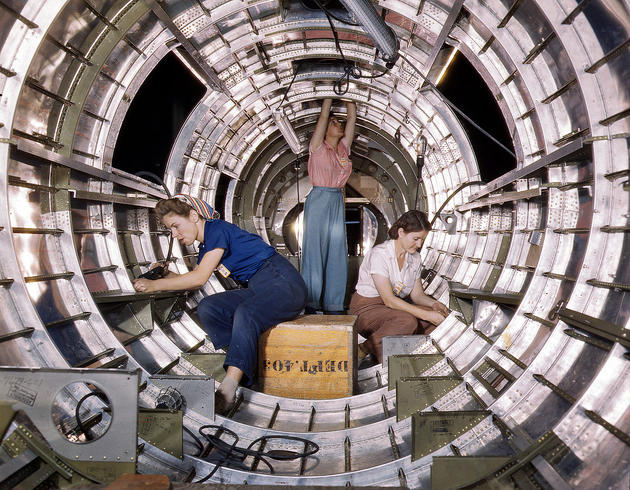
A woman works at a military factory, 1942. 
1943 year. Total supplies under Lend-Lease amounted to about $ 50.1 billion (equivalent to about $ 610 billion in 2008 prices), of which $ 31.4 billion was supplied to Great Britain, $ 11.3 billion to the USSR, $ 3.2 billion to France and $ 1.6 billion to China. 
Nebraska, 1942. 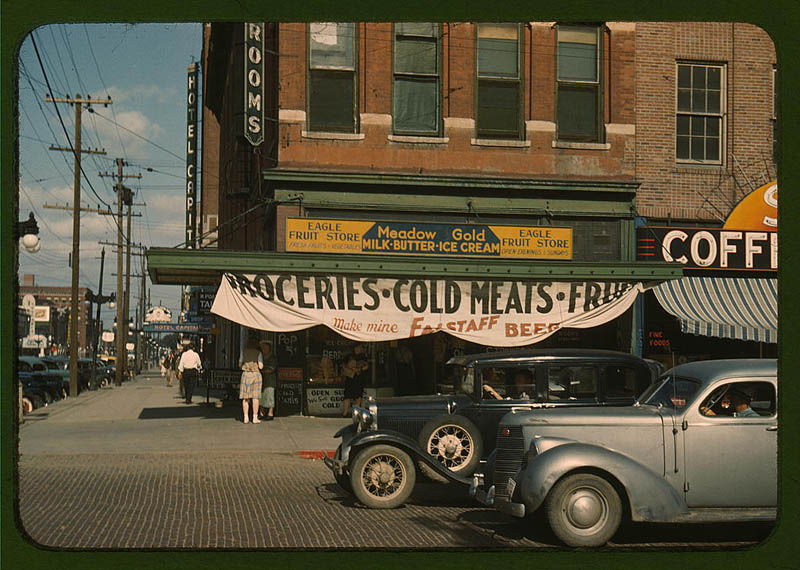

New York, 1942. A girl looks at a shop window with religious attributes. 
1942 year. Electric device for wringing out the laundry. 
Mom and daughter are washing dishes in their home. Connecticut, 1942. 
Texas, 1943. ![]()
Rural schoolchildren. State of Texas, April 1943. 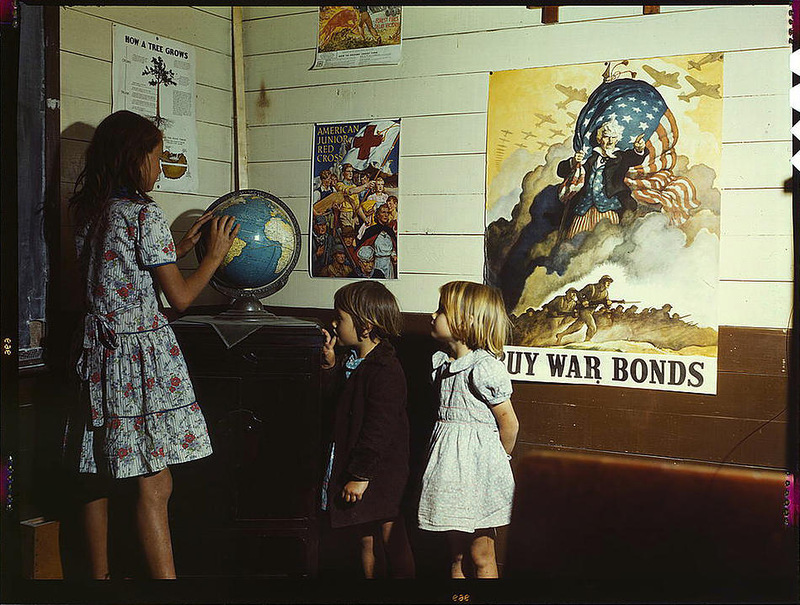
Bus station. Memphis, Tennessee, 1943. 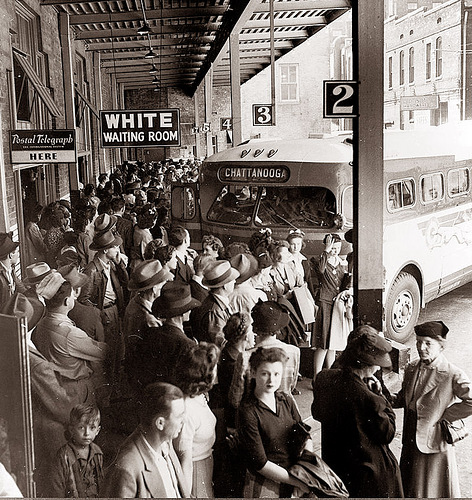
Hollywood, Los Angeles, 1944. These photos give a good idea of real fashion in the mid 40s of the USA. 
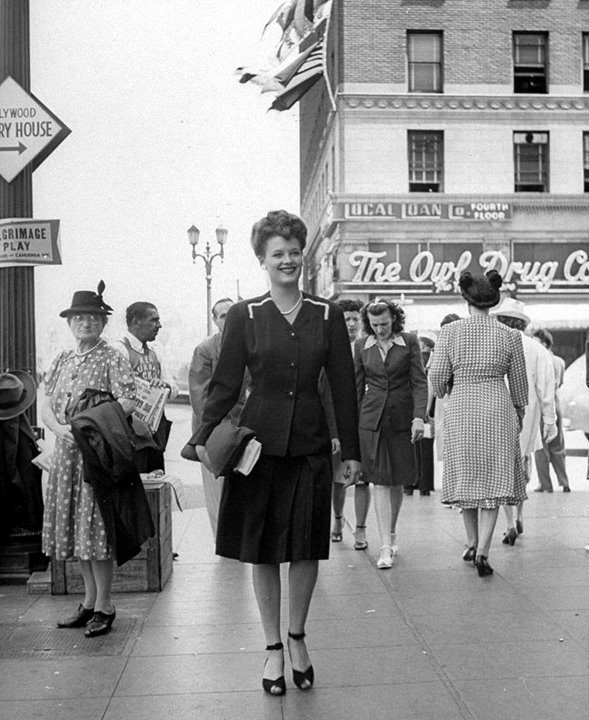

1947.
And this is not an illustration of the monstrous system of capitalism, on the contrary, earlier in the USA there was much more of this capitalism. However, now the share of state property in the national economy has increased significantly, reaching almost half of the GDP, and groups close to the political establishment are fishing in this murky water. In conditions of pure market competition, such a social stratification is difficult and arbitrarily huge accumulated super profits after the death of the founder of a business empire will immediately be profaned by spoiled heirs. The system of state interventionism allows these empires to live longer by limiting competition and sitting on government orders and subsidies, with minimal personal talent and limited only to political connections.
Introduction
Chapter 1. Characteristics of 20th century American culture
1 Popular American culture of the 20th century
2 Philosophical and religious views of the United States
Chapter 2. US art in the twentieth century
1 US Literature
2 Cinematography of the USA
Conclusion
Introduction
The relevance of the research topic is justified by several positions. First of all, due to the fact that the American culture of the twentieth century was such a variant of the global culture, whose hallmark was the high development of technical devices and, especially, the degree of their accessibility to any person. Careful studies of distribution and diffusion would show that the foundations of this civilization were formed in North America, Western Asia and Europe. However, 20th century American culture was no longer colonial. These positions determined the choice of this topic.
The question of European influence on American culture - the ratio of the original and the borrowed - has been raised for a long time. Even before the French aristocrat Alexis de Tocqueville made his famous trip to the young republic in 1831, about 1,200 French people had already formulated the problem. Was there anything new in their feedback on American civilization? This issue has been debated for over 150 years. Political convictions, economic views, class prejudice, racism, nationalism, vanity and pride all mattered in the controversies that took place on both sides of the Atlantic.
However, in the twentieth century, driven by the growing wealth and power of the United States, the debate about American culture took a different direction. The old question resounded in a new key. Once upon a time, Europe's influence on America was a sensitive, even emotional issue in the United States. Today it is of little interest to the general public, and only cultural historians continue to discuss it. On the contrary, the issue that is now being discussed and sometimes hotly debated outside of America is its cultural influence (whether the word "cultural" is spelled with a capital letter or a small letter) on the rest of the world. After World War II, Americans were surprised to hear accusations of "cultural imperialism" and "nationalism." Unfortunately, this new problem is often discussed with as little objectivity as the old one.
The goal is to analyze the features of American culture of the twentieth century.
-to identify the characteristic features of US culture in the 20th century;
-describe the art of the United States in the 20th century.
Chapter 1 Characteristics of 20th Century American Culture
1.1 Popular American culture of the 20th century
One of critical factors, defining the nature of culture in the second half of the XX century, - the scientific and technological revolution. Its influence is manifested in all aspects of the material and spiritual life of society. The industrialization of culture also took place under its influence.
The industry of mass culture began to develop at a rapid pace and play an increasing role in the mid-40s, after the Second World War. The production of films, literary works, products of new industries, such as television, video recording, was put on a streaming basis. And it was in the United States that this phenomenon was most widespread.
As features historical development The United States and its dominant position in the Western world have led to the fact that, when speaking of mass culture, they primarily mean American mass culture, the one that determines spiritual life in the United States and is exported to capitalist European, and since the 90s biennium and to former socialist countries as well as developing states. The latter circumstance testifies to the constant striving of the United States not only for economic, political, but also for ideological, spiritual domination in the world.
In the development of mass culture in America, the specificity of the policy of "melting in a crucible" was largely manifested.
After World War II, the industry of American popular culture, having received even greater development within the country, overwhelmed Western Europe with its products.
The United States was not the arena of hostilities during the war, the country was not destroyed, and the Americans did not have to endure either occupation, or famine, or the difficulties that befell the peoples of Europe and Asia. The United States did not face the difficulties of post-war economic recovery and the old, peaceful way of life. On the contrary, the USA developed industry, the country became rich.
Claiming a dominant position in the world, the United States sought to impose its ideology and way of life on Western European countries. A popular culture that was built to American standards and promoted the American way of life could best serve these purposes. The European countries, destroyed by the war, did not have the opportunity in the post-war years to actively develop their own culture. As a result of the fascist occupation, European culture suffered enormous damage, due to the lack of a technical and financial base for the development of its own culture. It should also be noted that part of the creative intelligentsia of the countries Western Europe was exterminated by the Nazis or emigrated to the United States. Therefore, the Europeans had to be content with the products of American mass culture, which, after all the horrors of the war, took the mass consumer away from the difficult reality into the ghostly world of well-being, " beautiful life”, Into the world of“ equal ”opportunities for all,“ equal ”chances for success and happiness for all.
January 1948 in the United States was signed the law on the exchange in the field of information and culture, which was called the Smith-Mundt Act. This law empowered the American government to take the necessary measures to promote mutual understanding between the American people and the peoples of other countries.
Naturally, the Americans were drawn to Europe - military personnel, businessmen, advisers and specialists in various fields, including representatives of propaganda and information services, as well as tourists. They were brought to Europe from overseas and propagated through "light" literature, newspapers, videodisks, entertainment films, advertising brochures the products of mass culture. Later, the United States Information Agency (USIA), established in 1953, joined this campaign.
The true pioneer of the aesthetics of mass culture was Hollywood, whose masters developed and systematized economic and organizational methods, ideological and advertising-propaganda goals of the conveyor method of film production, expelling by all means the creative competition of talents and replacing it with commercial competition.
Submission of the entertainment genre to the task of maximizing profit and the desire to please all tastes leads to the fact that commercial products are afraid of genuine innovation and, not feeding on the life-giving juices of a multifaceted life, inevitably revolves around a limited proven range of themes and plot structures; sex, adventure, and mindless fun - these are the finds, borrowed, as a rule, from the tabloid literature, which now constitute the main content of almost all forms of commercial art in the United States.
In the United States, “mass culture” initially promoted the stereotypes and ideas of official culture, the main regulator of which was advertising. "Popular culture" has become such an integral part of the culture of American society, its cultural consciousness, that its study exceeds in the system, for example, American higher education. 56% of training courses in the United States are devoted to the study of "popular" types of culture (courses in television, film, advertising, journalism). In America, "popular culture" has taken on a twofold character: the American mind, which is not busy with practical concerns, remains a rest, while another part of it is occupied with discovery, production and social organization. American will is embodied in a skyscraper, American intelligence in colonial buildings.
1.2 Philosophical and religious views of the United States
Since the beginning of the XX century. The most widespread in the United States was pragmatism, which had a great influence on various areas of the country's cultural life.The founder of this trend was C. Thirce (1839-1914), and its largest representatives were W. Geme (1842-1910), J. Dewey ( 1859-1952), J. Mead (1863-1931). Pragmatism differs from other forms of subjective idealism in that it takes as the basis of its constructions not sensations, but the goals, intentions, tasks of the acting subject. Not "what is true is useful", but "what is useful is true" - this is the principle of pragmatism.
In the first quarter of the XX century. two schools of realism emerged: neorealism (R.B. Perry, 1876-1957; W.P. Montague, 1873-1954, etc.); critical realism (R.W.Selshre, 1880-1973, J. Santayana, 1863-1952, C.O. Strong, 1862-1940, etc.). The emergence of these schools brought a noticeable revival to philosophical life.
Contemporary philosophy in the United States presents a very variegated picture with many philosophical currents. Pragmatism has lost its former dominant position. Protestant philosophy appears either in the form of personalism or in an openly fideistic form. In recent years, Catholic neo-Thomist philosophy has become much more active.
Statistics in the US state that over 90% of Americans believe in God. Since 1955 it has been printed on dollar bills; "God is with us".
Protestantism is most widespread in the United States. Moreover, the United States became the world center of Protestantism; the headquarters of Baptists, Adventists, Jehovah's Witnesses, and others settled here.
Modern Protestantism is characterized by a striving for integration, which found expression in the creation in 1948 of the World Council of Churches, for whose burden of existence 300 religious associations from 100 countries of the world with 440 million believers became its members.
The ideology of Protestantism is based on the doctrine of the reformers (Martin Luther, 1483-1546; John Calvin, 1509-1564, etc.) on salvation by personal faith, on the priesthood of all believers, on the exclusive authority of the Bible, on the right of every believer to preach and perform worship without intermediaries (church, clergy).
Protestantism abolished the church hierarchy, abandoned monasteries and monasticism. Prayer houses are freed from the magnificent decoration of altars, icons, statues, there are no bells. Divine services are extremely simplified and reduced to preaching, prayer and singing psalms and hymns in their native language.
Currently, Protestantism in the United States is a collection of independent churches, organizations and sects. One of the largest churches in the United States is the Protestant Episcopal Church, which is identical to the English one, and has 3.5 million active members. This church is active in missionary work both in the United States and abroad.
More than 120 independent churches and 5 million followers in the United States have Pentecostals. They also from the very beginning did not limit their activities to the borders of their country, but sought to spread the ideas of "Holy Pentecost" all over the world.
Such followers of the Protestant movement as the Baptists also became widespread in the United States. Baptists consider the Bible (primarily the New Testament) to be the only source of doctrine. Baptists do not recognize saints, monasticism, focusing on Jesus Christ as the only mediator between God and people, who, by sacrificing himself, saved sinners. The main principle: "Live in the world, but be not of this world," that is, obey earthly laws, but give your heart entirely to Christ.
The preaching of the inevitable "sinfulness of the world" that lies outside the boundaries of the community, strict adherence to the simplest moral standards (refusal to drink alcohol, profanity, mutual support and assistance) are very attractive to people who have felt the injustice and callousness of others. Baptists give particular attention to the preaching of their faith, which everyone is obliged to preach (the principle of the universal priesthood), especially among children and young people.
In 1976, 20% of Americans considered themselves Baptists, compared with 70% of blacks. American Baptism plays a leading role in the World Baptist Union, with over 7 million members. Baptism is the largest Protestant organization with huge capital and its own universities, magazines, newspapers, publishing houses, missionary societies, etc.
Baptism is now an essential component of Americanism. The Baptists have nominated many theologians and social thinkers who have significantly influenced the face of modern American Protestantism and culture in general. Among them are the founder and theologian of "social evangelism" W. Rauschenbusch (1861-1918), the unorthodox theologian and social thinker R. Niebuhr (1892-1971), W. Graham (b. 1926) - the founder and head of the "World Evangelical Association", author of many books, owner of radio stations and various publications
Graham shapes evangelical doctrine at the level and means of mass culture, using the impressive images and symbols of Christianity; Martin Luther King (1929 - 1968) - one of the leaders of the struggle for the civil rights of blacks in the United States, a Baptist theologian. His "direct nonviolent action" tactics have played a decisive role in undermining the system of segregation and discrimination against black Americans. Finally, radio evangelist J. Falwell (b. 1933) has hosted the popular TV program "The Hour of the Old Times Gospel" since 1971. Falwell's views are most clearly expressed in Listen, America! and "Fundamentalist Phenomenon".
But one of the largest American Protestant churches is represented by the Methodists. The Methodist doctrine is based on the well-known principles of Protestantism - recognition of the authority of the Bible as Scripture, upholding the priesthood of all believers, etc .; two rituals are sent - baptism and communion. The history of Methodism is replete with various schisms, the emergence of separate independent church organizations, which subsequently united. In accordance with the charter, Methodists decide all church affairs at their annual and general conferences (every four years). General conference, which is attended by representatives from the laity, is the highest legislative body of the church. Methodists are active members of the National Council of Churches of Christ. There are currently over 14 million Methodists in the United States, united in 23 churches. The largest (about 10 million) is the United Methodist Church, formed in 1968 by the amalgamation of several Methodist denominations.
Chapter 2. Art of the USA in the XX century
2.1 US Literature
The United States announced its entry into the First World War in April 1917, and took part in hostilities a few months before the signing of the armistice. America did not fight on its territory, but its literature did not pass by the "lost generation." The problems associated with the war, the pathos of the war, its heroes were included not only in the books of those writers who fought on the fronts of Europe, like E. Hemingway, but also affected a wider range of authors and works, intertwined with other problems specific to America, with the topic of big money in America in the twenties; and the collapse of the American Dream. The war caused bitterness and anger, helped to see the light and see the true value of things, the lies and inventiveness of official slogans. The war became a kind of university for young men who went to the European front to gain courage and gain insight.
The first half of the century turned out to be fruitful for the development of all directions in American literature, discovered the names of T. Wolfe, W. Faulkner, J. O "Neal, E. Hemingway, F. S. Fitzgerald, D. Steinbeck. the authority of US literature. The activity of John Reed received a great response, the publication in 1919 of his book "Ten Days that Shook the World." This book brought to America the living breath of the revolution in Russia. As a result of the collapse of the New York Stock Exchange in America, there was a "Great Depression" and demonstrations of unemployed people took to the streets, at which the army opened fire. During this period, more than 100 thousand applications were written in the United States asking to move to Russia. American writers create John Reed's clubs , are promoting revolutionary literature, calling for a new discovery of the tragic America of the disadvantaged.
The thirties went down in American history as the "red thirties". In terms of the severity of the social, political and economic crisis, they have no analogy in the entire two-hundred-year history of the United States. And although the "Great Depression" was officially overcome in 1933, its presence in literature goes beyond the designated limits. The experience of those difficult years has forever remained in Americans as an immunity against complacency, carelessness, and mental indifference. It formed the basis for the further development of the national formula for success, and helped to strengthen the moral foundation of American business. This experience gave a "second wind" to the school of critical realists, who carry on the tradition of "raking mud". On the basis of the new material, the writers began to thoroughly investigate the American tragedy, which has deep roots in the national consciousness.
One of the first to raise the theme of the American Dream and American tragedy was Sherwood ANDERSON (1876-1941), whose collection of short stories "Winesburg, Ohio" (1919) influenced the entire post-war generation of American writers. S. Anderson wrote about the loneliness and alienation of "grotesque people" (after the title of one of the stories in the collection "The Book of Grotesque People"), eccentrics who do not fit into American standards, who find themselves on the sidelines of life. Anderson wrote little, nevertheless his name has become firmly established in the history of national literature. It accompanies the biographies of Hemingway and Faulkner, who received parting words from a senior colleague, assistant and teacher, who, however, inherited from his students, who not only took over much from him, but also talentedly parodied him in places of deliberate steel and weak novels. Gertrude Stein noted that Sherwood Anderson was unrivaled in conveying feelings using syntax, which has always been characteristic of American literature.
The first American writer to be awarded the Nobel Prize (1930), Sinclair LEWIS (1885-1951), considered the novel Main Street (1920) to be the beginning of his literary career. A theme typical for American literature - the life of a provincial town in "one-story" America received in it the status of a national disease, the name of which is provincialism and lack of spirituality. The town of Gopher Prairie in Minnesota was supposed to represent any town in any state, and its main street is "a continuation of the Main Street of any other town." The depressing life of the provinces, the triumph of mediocrity and complacency are all the more obvious because they are shown in the perception of a living person, a young woman Carol, who arrived in Gopher Prairie with her husband, as ordinary and boring as his hometown. Carol tries to shake up the life of the town, to wake up its inhabitants with good initiatives, but to no avail. The "red Swede" Miles Bjornstam, a socialist and a lone rebel, is harshly condemned to the stagnation of the mind and the wilderness of feelings.
Influenced by Lewis's novel, a group of American journalists, based on their study of the life of the middle towns of America and conversations with their inhabitants, published the documentary book "Middletown" (1921). This book confirmed the diagnosis made by the writer, drew attention to the pathological praise of everything American by patriots, to the feeling of fear and depression of the inhabitants: small towns forced to bear the burden of "healthy Americanism." The standards of Americanism in the image of an average businessman and one hundred percent patriot are derived in Lewis's novel "Babbitt" (1922), where the problematics of "Main Street" big city and businessmen of a different rank - the social phenomenon of "babbitism".
The "poetic renaissance" of the turn of the century is represented by a galaxy of talents that revived American poetry after the "twilight period" that followed the death of Whitman. This is a realistic creativity, leaving in folklore, trying to comprehend the path traveled by America in half a century after the end of the Civil War (1865), synthesizing two leading traditions: Whitman's and romantic, coming from Henry Longfellow and Henry Thoreau. It is characteristic of American realism as a whole that it continued the humanistic and democratic quests of romantic writers (Cooper, Hawthorne, Melville).
An unprecedented success, thousands of copies fell to the Spoon River Anthology (1915), the author of which was one of the brightest talents of realistic poetry, Edgar Lee MASTERS (1868-1950). The everyday life of an unremarkable town in the Midwest and several generations of its various inhabitants - from the mayor and bosses of the business to homeless vagabonds and black servants - was presented as an example of unfulfilled democratic ideals. The book, which consists of two hundred and fifty epitaphs, contains many memorable dramatic portraits and confessional monologues. Heroes of the revolution and just workers, a gardener and a rural artist, a poet and a clerk - not all of them have withstood the test of an empty life. The book showed the author's satirical talent, subtle irony. It widely presents documents and journalism, which made it possible to create a kind of historical cast of the era, anticipating the critical pathos of the books of Hemingway and Fitzgerald, the problems of the novels "Winesburg, Ohio" by S. Anderson and "Main Street" by S. Lewis, the play "Our Town" T Wilder.
2.2 Cinematography of the USA
Cinematic art plays a very important role in US culture. Each year, film companies in the United States release hundreds of films, attracting millions of viewers to theaters and generating billions of dollars.
Back in the nineties of the XIX century, the famous American inventor Thomas Edison demonstrated his device for displaying a moving image - a kinetoscope. Well, after the appearance in 1895 of the Lumière brothers' cinematography, cinema began to rapidly gain popularity among the public.
At the same time, the first film companies appeared in the United States, and by the beginning of the 20th century there were already dozens of them in the country. Most of them were located in New York<#"justify">It is believed that with the release of The Jazz Singer, the Golden Age of Hollywood began. In the next thirty years, until the end of the fifties, thousands of films were released. The genres of the main genres of films (westerns, comedies, melodramas, musicals, thrillers, etc.) were clearly defined, a system of film production was formed, and the concept of "movie star" appeared.
Most of the films were shot by major film companies. In those years, there was a generally accepted "studio" system in which directors, actors, screenwriters and other filmmakers were contracted to a particular film studio. It was possible to find out which studio made a particular film by the cast of the picture. Under the studio system in Hollywood, the producer of the film had more weight than its director. The artistic value of the film mattered far less than the profit it made.
At the same time, during the "Golden Age of Hollywood" such masters of cinema as Clark Gable, Greta Garbo, Walt Disney, Alfred Hitchcock and many others became famous.
In 1937, Walt Disney released his famous cartoon "Snow White and the Seven Dwarfs", which became the highest-grossing film of its time and showed that animation has a great future.
In 1939, what is considered the most successful (commercially) film in American cinema, Gone With the Wind, was shot.
In 1941, the film Citizen Kane, directed by Orson Welles, was released, which many film critics still call the best film of all time.
The sixties and seventies of the XX century are known in the history of American cinema as "New Hollywood".
By the early sixties, the "studio" system of filmmaking had begun to falter. There were several reasons, including US antitrust laws and the advent of television.
The period of "New Hollywood" is characterized by a departure from the established standards in cinema, the strong influence of European cinema, and numerous artistic experiments.
In these decades, for the first time such famous names like Steven Spielberg, Francis Coppola, George Lucas, Martin Scorsese, Roman Polanski and others.
In the seventies, the concept of a blockbuster appeared - a film with a large budget and large box office receipts. Among the first blockbusters in Hollywood are "Jaws" and " star Wars".
Conclusion
american culture literature cinematography
At the turn of the XIX-XX centuries. the United States moved to the first place in terms of economic development, and the center of world economic development moved from Europe to America. The United States began to produce industrial products the most and the fastest. The success of the economic development of this country was due to a number of socio-economic, historical, natural and geographical factors. The radical nature of the bourgeois-democratic revolution of 1861-1865, as well as the widespread use of the achievements of the second scientific and technological revolution, which gave the world new means of communication, electricity, automobiles and aircraft, a continuous (conveyor) production system and much more.
The economic and technical rise of the country has become a significant factor in all-round development in the 20th century. not only the material, but also the spiritual culture of the United States, according to the level of which this country occupies a leading position in the world. The main feature of the process of development of the culture of the United States, as well as of European countries, apparently, should be recognized the mutual intersection of the old and the new, the development of tendencies that preserve the past, and innovative tendencies that deny the past. Therefore, society asks questions about why art exists, what it can do, what it means. But there is no single answer, and art and culture itself endlessly put forward new styles and forms.
The culture of America was formed gradually, inheriting and absorbing the culture of all former colonies European countries.
In the literature of the XX century national characteristics affected very tangibly. Suffice it to recall T. Dreiser and his novels: "Sister Kerry", "The Financier", "Titan", J. London and his novels "Martin Eden" and "Iron Heel", where he revealed the tragedy of an artist from the people. T. Dreiser's novel American Tragedy, which debunks the myth of "equal" opportunities for all, has become one of the largest literary works of the 20th century in American literature. E. Hemingway writes the novel For Whom the Bell Tolls, where he raises the most pressing problems associated with the painful turning points in history. In the prose of the 80s and 90s, the theme of spiritual emptiness and the dominance of a pseudo-culture that prompts the hero to revolt, often of a destructive nature, prevails. Other notable American writers include Walt Whiteman, Herman Merville, Nathaniel Hevthorn, Emily Dickinson, Henry James, Edith Worton, William Faulkner, Francis Scott Fitzgerald, John Steinbeck, Arthur Miller, John Updike and Toni Morrison. And James Elroy and Elmore Leonard are the most famous American detective writers.
America's musical culture is rich in traditions, genres, and styles. Concert activities are of particular importance, as there is a wide network of concert halls practically throughout the country. The American music industry is the most powerful in the world. African American musical influences, including blues, jazz and hip-hop, have long since spread throughout the world.
American theater has a comparatively a little story its own stage culture, and therefore American drama lagged behind not only European drama, but also American literature. The buildings built in the early 20th century on Broadway and the adjacent streets of New York with vaudeville, revues, and later musicals stuck to the name "Broadway Theater". High-end musical performances on Broadway, if successful, are on a daily basis and have been on the stage for several years.
American culture it manifests itself most strongly in the film and television industries. Mostly people from other countries form an opinion about America after watching feature films and television programs.
List of sources used
1.Culturology Tutorial for university students / Ed. G.V. Dracha, Ministry of Education of the Russian Federation - Rostov n / a: Phoenix, 2003 .-- 572 p.
2.Culturology A.Yu. Novikov, I.V. Topchiy - Rostov on / D: Phoenix, 2002 .-- 320 p.
Fedulov A.M. Culture of the USA of the XX century. - M., 1995 .-- 245 p.
Cherenkov M.B. Philosophical and religious views of the United States of the 20th century. - M., 1999 .-- 301 s.
Shurinov V.S. US culture of the 20th century. - M., 2000 .-- 249 p.
Work order
Our experts will help you write a job with mandatory verification for uniqueness in the "Antiplagiat" system
Send a request with requirements right now to find out the cost and the possibility of writing.
The rise of the economy. Since the end of the Civil War and the Reconstruction of the South, US industry and agriculture have developed at an unprecedented pace in the world. By the end of the XIX century. The United States has become a powerful industrial power. They came out on top in the world in terms of industrial production, growth rates, technical equipment, and labor productivity. In the United States, iron and steel were smelted, and more coal was mined than in England, Germany and France combined.
The country had natural resources, a favorable climate, and had access to the world's oceans. Already in the 70s. the foundations were laid for a high concentration of production and capital. Metallurgy and mechanical engineering, the foundation of an industrial power, developed rapidly. Steel smelting, for example, increased from 1870 to 1900 150 times and amounted to more than 10 million tons. Factory machine building spun off into an independent industry, making qualitative changes in the technological processes of other industries. Much attention was paid to the development of science and technical progress. Over 40 recent years XIX century. 676 thousand patents for discoveries and inventions were registered.
A democratic solution to the land question opened the way for the rapid development of capitalism in agriculture. The implementation of the Homestead Act, which eliminated the danger of slave owners seizing Western lands, led to the development of a huge territory of 80 million acres, the emergence of new states, and the formation of a capacious domestic market. Crop areas expanded rapidly, machinery and fertilizers were applied, which contributed to the growth of agricultural production and the transformation of the United States into its main exporter to world markets.
Colonization of the western regions required construction railways... To speed up the construction of railway lines, the state allocated large territories and large subsidies to companies. As a result, by 1900 the length of the US railroad line exceeded the length of all European railways. Railway construction itself stimulated the development of industrial production, for metal, rails, steam locomotives, and carriages were needed.
Foreign capital played an important role in the economic recovery, as well as the use of the scientific and technical experience of the Old World. American production did not experience a particular shortage of labor, as there was a continuous flow of immigrants into the country. Immigration was encouraged in every possible way. About 400,000 migrants arrive in the United States every year. Over the past 30 years of the XIX century. 14 million people moved here, and at the beginning of the new, XX century. - another 14.5 million. The influx of the population expanded the possibilities of the domestic market.
At the beginning of the XX century. accelerated the process of concentration and centralization of production and capital, the formation of monopoly associations, mainly in the form of trusts. The industrial and financial empires of Morgan, Rockefeller, Mellon, which controlled the economy, had a huge impact on the political life of the United States.
Domestic policy. In the XIX century. in the United States, a republic of a pronounced presidential type with a two-party system was finally established. The political process developed towards strengthening the executive power. The state apparatus grew, the composition of the police increased, and the army was strengthened. This was dictated both by the internal interests of the American bourgeoisie and by preparations for colonial expansion.
In the political arena, there were two parties that arose before the Civil War. The backbone of the Republican Party was large industrialists and financiers of the north-east of the country. The Democratic Party represented the interests of large landowners, farmers, industrialists in the South and West of the United States. The discrepancies between the parties gradually faded, since both of them defended the big owners. Attempts to create a third party reflecting the interests of the petty-bourgeois strata were unsuccessful. The socialist movement was not strong enough in the USA either, since the position of American workers compared to European ones looked better and they were limited by the framework of economic demands.
Democratic freedoms, solemnly proclaimed by the American constitution, were in many cases still a declaration. Women, emigrants for the first five years, and seasonal workers did not have political rights. In the southern states, there was an electoral tax, so millions of poor people were virtually unable to exercise the right to vote. The indigenous people, Indians, who were destroyed or forced into remote desert areas, and their lands were seized, were persecuted. For the Indians, special settlements were created - reservations. Blacks freed from slavery continued to live in discriminatory conditions. Separate schools, churches, restaurants, places on transport were created for them, and marriages between whites and blacks were prohibited. It took a generational change for a democratic civil society to form in the United States.
The aggravation of social contradictions gave rise to mass democratic movements. Among them, the most significant were the farming movement of the 70s - 90s, which passed through three waves (grangers, greenbackers, populists), an anti-imperialist movement directed against the expansion of the United States into neighbouring countries... The movement of "mud rakes" caused a great resonance, bringing together progressive writers, journalists, scientists and students. They publicly denounced the negative aspects of American life. The Negro movement for equal rights expanded.
With the growing discontent of the masses and the rise of anti-monopoly movements, the ruling circles were forced to switch to a policy of reformism. President Theodore Roosevelt, a Republican nominee who was in power from 1901 to 1908, proposed a reform program. It included control over trusts, state regulation of socio-economic problems, democratization of political life. Roosevelt believed that the state, contrary to the doctrines of liberalism, should limit the desire of trusts to establish a monopoly position in the market, as well as intervene in the relationship between labor and capital to avoid the threat of revolution. The government should be an arbiter between workers and entrepreneurs, and should pursue an "honest course" on the labor issue. The reform policy was continued by the democrat Woodrow Wilson, who was elected president of the United States in 1912. His program, called the new democracy, fit into three points - individualism, personal freedom, and freedom of competition. Wilson offered the Americans not control over trusts, but regulation of competition.
Main directions foreign policy... Until the end of the XIX century. The United States did not interfere in European affairs, pursuing a policy of "isolationism". But economic prosperity spurred the growth of expansionist ideology. A number of theorists and politicians were called upon to substantiate and justify the subordination of other peoples, to put forward the slogan of transforming the United States into a world power. The construction of a powerful navy was launched.
T. Roosevelt made a great contribution to the formation of the US foreign policy doctrine. He moved away from the traditional orientation towards the internal market, using the conditions created as a result of the accelerated development of capitalism for the country's entry into the world arena. Roosevelt made a turn towards European policy, abandoning the previous "isolationism", went to rapprochement with England.
The Spanish-American War of 1898 marked the beginning of the creation of the American colonial empire... As a result of the victory over the decrepit Spain, the United States acquired Puerto Rico, a number of islands in the basin Caribbean, took control of Cuba. On Pacific they captured the Hawaiian Islands, about. Guam, enslaved the Philippines, received part of the Samoa archipelago, which opened the way for them to China. But the European powers and Japan, which had enslaved China by that time, resisted the penetration of American capital. Then the United States came out with the doctrine of "open doors", demanding to provide access to China for all powers.
With the help of the dollar and goods, the United States established control over the Latin American states. They modernized the Monroe Doctrine, announcing that they take responsibility for resolving conflicts between America and Europe and can deploy their armed forces in Latin American countries in the event of unrest. This course is called the big stick policy. The United States has repeatedly deployed its armed forces in many countries of Latin America. Development of culture. In American literature, the first half of the XIX v. romanticism became widespread, which arose as a result of American disappointment in the realities of life, where the dollar ruled. Unlike European romanticism, American romanticism is still quite optimistic. He is looking for his heroes not in the distant past or a vague future, but in American reality. American romantics spoke out against the corrupt world, the negative sides of American life. The work of Fenimore Cooper, who created an encyclopedia about American pioneers, is characterized by humanism and sympathy for the native people of America. He understood that the destruction of the Indians leads to the death of a unique culture. Henry Longfellow, in the poem "The Song of Hiawatha", written based on Indian legends, praised the hero who fights for the independence of his people.
A special page in American literature is represented by works that denounced slavery. An event in public life was Harriet Beecher Stowe's novel "Uncle Tom's Cabin", which shows the horrors of slavery, the inhuman treatment of blacks by planters. The poet Walt Whitman in the poem "Leaves of Grass" glorified the working people of America. Another of his poem "When the lilac bloomed in the yard in front of the house" is dedicated to President A. Lincoln, the hero of the Civil War.
V late XIX v. naturalism became widespread in American literature. The most significant works of this artistic movement were the novels by Stephen Crane (Maggie - the girl of the street) and Frank Norris (Octopus, Whirlpool). They provide true pictures of the life of the working people of American cities. Elton Sinclair's books "The Jungle" and "The King of Charcoal" show the contrasts of social life.
The assertion of realism is associated with the name of Mark Twain. It is characterized by a satirical social novella, the object of which was the "gold" fever that swept America. In the books "The Adventures of Tom Sawyer", "The Adventures of Huckle-berry Finn" pictures of American provincial life are drawn. The Gilded Age shows unsightly scenes of predation by businessmen after the victory of the North over the South.
Jack London's works are deeply realistic. His stories about sea adventures, about gold diggers in Alaska, the novels "People of the Abyss", "Iron Heel" are included in the golden fund of world literature. The novel "Martin Ideas" shows the tragic path of a man who came out of the lower classes and was broken by the system of entrepreneurship in art. Theodore Dreiser's books "Sister Carrie", "Jenny Gerhardt", "The Trilogy of Desire" raised social problems, exposed the causes of trouble in rich America.
V American painting the influence of romanticism is noticeable in the works of T. Sally and T. Cole. J. Whistler and M. Kas-sat, who were influenced by the French impressionists, showed themselves as realists. For J. Sargent, the master of portrait, strict restraint and persuasiveness are characteristic.
In the works of W. Homer, T. Aikins, realism has reached emotional depth. Homer's paintings are characterized by clarity of composition and drawing, attention to detail. He loved to draw ordinary people - farmers, hunters, sailors, those who live in collisions with nature ("Hunter", "Gulf Stream"). T. Akins gravitated towards urban scenes. He showed people of art, science ("Walt Whitman", "Dr. Gross in the clinic").
The growth of industrial production and urbanization required new materials and new types of structures. The development of cities and the tightness of buildings caused a rise in land prices. This led to an increase in the height of buildings, the invention of the elevator, the improvement of the metal frame. A new architectural style appeared - constructivism. The names of architects Lewis Sullivan and Frank Wright are associated with it. They created the first skyscrapers, projects of large public buildings - banks, shops, museums, abandoned decorative ornaments. Wright did a lot to create a new type of country house, using the features of the natural landscape.
DOCUMENTS AND MATERIALS
FROM PRESIDENT T. ROOSEVELT'S MESSAGE TO CONGRESS (December 3, 1901)
♦ The development of cities proceeded immeasurably faster than the development of the countryside, and the emergence of large industrial centers was accompanied by an astounding rise in fortunes not only in general, but also in the hands of individual wealthy individuals and especially in the hands of very large corporations ...
This process engenders a major antagonism, largely unjustified ... The captains of industry have built a network of railways across our continent, set our trade on their feet, developed industrial production ...
All this is true, but it is also true that there is a real and great evil, one of the main manifestations of which is excessive concentration with many of its disastrous consequences ...
The activities of corporations operating on a federal scale must be regulated if these activities are found to be detrimental to society ... The first thing for formulating corporate policy is knowledge of the facts, that is, publicity. In the interests of society, the government should have the right to inspect and verify the activities of corporations operating on a federal scale ... "(Collection of documents on the history of the New Time. 1870 - 1914: Textbook / Compiled by P. I. Ostrikov, P. P. Wandel M., 1989.S. 183 - 184).
SPANISH-AMERICAN PEACE TREATY SIGNED IN PARIS DECEMBER 10, 1898
"Art. 1. Spain renounces all of its rights and claims to sovereignty over Cuba.
Since the island, after its evacuation by Spain, must be occupied by the United States, the United States will have obligations during the entire period of this occupation that may arise from international law from the fact of their occupation, to protect life and property.
Art. 2. Spain cedes to the United States the island of Puerto Rico and other islands now under Spanish sovereignty in the West Indies, as well as the island of Guam in Mariana Islands, or Ladronach.
Art. 3. Spain cedes to the United States the archipelago known as Philippine Islands... The United States will pay Spain an amount of $ 20 million ... "(Yurovskaya E. Ye. Workshop on new history... 1870 - 1917.Moscow, 1979.S. 263).
QUESTIONS
1. What are the reasons for the US economic recovery after the Civil War?
2. What is characteristic of the US political system?
3. Why did the ruling circles switch to the policy of reformism at the beginning of the 20th century?
4. Why did the USA abandon the policy of isolationism?
5. What are the cultural achievements of Americans?
The First World War stimulated the economic development of the United States of America. During these years they found themselves in an unusually favorable position.
The United States has successfully used events in Europe to further enrichment. They acted as the main supplier of military materials, food and raw materials to the belligerent states. The value of American exports during the war years more than tripled - from 2.4 billion dollars. in 1914 to 7.9 billion dollars. in 1919 The total net profit of the American monopolies during 1914-1919. amounted to about 34 billion dollars.
Another major outcome of the war was the change in the international financial status of the United States: they became the main creditor European states and New York became an international financial center. The United States provided loans to European countries for military needs in the amount of over $ 11 billion.
Thus, an important outcome of the development of the United States in 1914-1919. there was a further increase in their economic power, strengthening of their position in the world economy, consolidating their position as the most powerful country in the world.
In the summer of 1920, the economic upsurge of the war and the first post-war years gave way to an economic crisis. In this first post-war crisis of overproduction, the contradiction between the production apparatus of American industry swollen on military orders and the narrow sales market caused by the purchasing power of the population appeared. The economic crisis has caused significant destruction in all spheres of the country's economic life. The volume of industrial production by April 1921 had decreased in comparison with June 1920 by an average of 32%.
By 1922 the number of unemployed reached almost 5 million people.
The industrial production crisis was intertwined with a deep and destructive agrarian crisis.
By 1923, the United States managed to overcome the economic difficulties caused by the aftermath of the First World War and the crisis of 1920-1921. The economic upturn that lasted until mid-1929 and the associated increase in the position of the United States in the world economy, and an increase in the standard and quality of life of Americans were called "American prosperity" in economic history (non-intervention of the state, "individualism").
"Great Depression" 1929-1933 and exacerbation of social contradictions. The panic on the New York Stock Exchange on October 24, 1929 was the first symptom of the crisis in the US economy, which grew into a crisis of the world capitalist economy as a whole.
The economic crisis of 1929-1933 was the deepest crisis of overproduction in the entire history of capitalism. For about four years, the economy of the capitalist countries was in a state of complete disorganization.
The gigantic destructive force of the crisis manifested itself in a sharp drop in industrial production. The total volume of American industrial output compared to the pre-crisis level of 1929 in 1930 was 80.7%, in 1931 - 68.1%, and in 1932 - 53.8%. The period from the summer of 1932 to the spring of 1933 was the time of the greatest deepening of the crisis.
In 1929-1933. there were about 130 thousand commercial bankruptcies. In four years, from 1929 to 1932, 5760 banks ceased to exist, i.e. a fifth of all banks in the country with a total amount of deposits of more than $ 3.5 billion.
In 1933 in the United States, according to government statistics, there were 12.8 million completely unemployed, whose share in the total work force accounted for almost 25%.
Reforms of the FD Roosevelt administration ("new course"), their results and significance. The theoretical basis of the "new course" was formed by the views of the English economist J.M. Keynes on the need for state regulation of the capitalist economy to ensure the smooth operation of the market mechanism.
The reforms of the new administration covered all spheres of the economy: industry, agriculture, financial and banking systems, as well as social and labor relations.
An emergency banking law was adopted, which was based on a differentiated approach to opening banks. Measures to "cleanse" banks have led to a reduction in their number. If in 1932 in the United States there were 6145 national banks, then a year later - 4890. In general, for 1933-1939. while the number of banks decreased by 15%, the volume of their assets increased by 37%.
In January 1934, the dollar was devalued.
The devaluation of the dollar, the withdrawal of monetary gold from private hands, and easier access to credit contributed to higher prices and created a mechanism for the inflationary development of the American economy, thereby giving the state funds to carry out reforms in other sectors of the economy.
The onset of the economic crisis in 1937 was unexpected. Only in 1939 did the US economy cope with its consequences, but before the Second World War the country did not manage to reach the pre-crisis level of production. The industrial production index in 1939 was 90 ° about the 1932 level. The unemployment rate was 6 times higher than the 1929 level and amounted to 17% of the labor force.
At the same time, the reforms of the "New Deal" were of great importance for the development of both the American and world economies. They demonstrated the role of state regulation in the system of the capitalist economy and showed that flexible and moderate regulation of the economy, especially during difficult periods of its development, is vital. Since the New Deal, government intervention in economic life, applied in various forms, has become an integral part of the US market mechanism. The most important result of the reforms was the fact that they marked a serious shift in the social development of the country.
Features of economic development in the first post-war decade.
During the war years, the national income of the United States doubled, and industrial production more than doubled. State-funded supplies of raw materials, food and military equipment to the Allies stimulated the renewal of fixed capital.
The war accelerated the process of agricultural intensification: the mechanization and chemicalization of production was stimulated by the huge demand for American food, which allowed farmers to dramatically increase their incomes.
With the end of the war, the country faced the problem of reconversion, i.e. transferring the economy from the military to a peaceful track. The reconversion took place under the control of the state. The sale of state-owned military factories and food supplies to private businesses was accelerated.
The implementation of the Marshall Plan and the Korean War helped to soften the post-war recession. The Marshall Plan provided for assistance to European states.
Thanks to the Marshall Plan, the United States got rid of surplus products that could not be sold domestically, and also managed to increase investment in the economies of European countries.
The American economy was stimulated by the Korean War, which began in January 1950.
During the Korean War, up to $ 30 billion was invested in US industry, i.e. more than in the entire Second World War. Depreciation of new industrial enterprises and equipment.
US entry into the second half of the 50s. XX century marked by shifts in economic and social development caused by the beginning of the scientific and technological revolution. It took place against the background of demographic changes and the further deepening of the urbanization process.
Automation of production has become a characteristic feature of scientific and technological revolution, in particular, the creation and use in production, banking, and the sphere of servicing electronic computers.
The science intensity of production increased rapidly.
The problems generated by the scientific and technological revolution demanded an expansion of the functions and a change in the role of the bourgeois state in terms of defining new priorities in the strategy of economic management. These new tasks of the state were reflected in the program of "new frontiers" proposed by the Democratic administration of J. Kennedy in the early 1960s.
The Kennedy government's socioeconomic program was based on the idea of stimulating economic growth.
In 1961-1962. the Kennedy government succeeded in pushing through Congress a number of important social measures envisaged in the New Frontier Program. Thus, the minimum hourly wage, which was $ 1 in 1955, increased to $ 1.25.
In the arsenal of means of state regulation, the administration widely used the levers of budgetary, tax and monetary policy. In 1962, the amortization period of fixed capital was shortened for all corporations and a tax credit was introduced on capital investments. These measures have significantly increased investment growth.
The beginning of Kennedy's presidency coincided with a cyclical boom in the economy. However, by the spring of 1962, the situation became more complicated: the growth rate slowed down, the unemployment rate stood at 5.5%, and the volume of capital investment decreased. In May of the same year, there was the strongest fall in shares on the stock exchange since 1929. This was partly due to the dissatisfaction of the top of big business with the policy of "benchmarks" in the field of prices.
Ultimately, the president was forced to go for some reorientation of his policy to please big business.
L. Johnson, who replaced J. Kennedy, who died tragically in November 1963, began to implement social reforms, which were called the "great society" program. Its central link was the "War on Poverty" aimed at improving the situation of the poorest segments of the US population. According to statistics, in 1964 there were 36.4 million poor people in the country, which amounted to about 20% of the population, i.e. people whose real incomes were below the "poverty line".
The attack on the problem of poverty was conditioned by objective reasons. First, mass poverty has become a serious brake on the production of labor and the provision of the required level of consumption in the conditions of scientific and technological revolution. Secondly, it created the ground for racial conflicts, exacerbation of social problems, an increase in crime, unemployment, etc.
Of the federal programs, an important place belonged to the preschool education program for children of the poor.
Health insurance was introduced for the elderly, and families with incomes below the "poverty line" were entitled to preferential terms of medical care through special federal subsidies to the states.
In 1968, the minimum wage was raised to $ 1.6. in hour.
All in all, the "fight against poverty" for the period 1964-1968. 10 billion dollars were spent, the total amount of social expenditures was by the end of the 60s. about 40% of the expenditure side of the federal budget. The allocation of these funds became possible due to economic growth: in 1961-1966. GNP increased by 4-6% per year. Among the main factors that contributed to the relatively rapid economic development of the United States during this period were: a) the high level of investment required to renew fixed capital in the conditions of scientific and technological revolution; 6) growth in consumer spending of the population; c) the growing role and scale of government regulation.
Aggravation of the contradictions in the socio-economic development of the USSR in the 70s.
In the fall of 1969, a sharp drop in industrial production began, amounting to 8% over the year. It affected both traditional and new industries generated by scientific and technological revolution. The unemployment rate exceeded 6% of the labor force, which amounted to about 5 million people. The value of shares on the New York Stock Exchange slid down, their rate fell by $ 300 billion. Corporate profits shrank, and large firms went bankrupt. The recession was characterized by rising prices and rising inflation.
The situation in the US economy deteriorated sharply in connection with the global energy crisis that developed at the end of 1973.
The energy crisis led to the crisis of the world capitalist economy in 1973-197 ^. In the United States, the crisis manifested itself in a more acute form than in other developed capitalist countries, but in terms of its indicators it was inferior to the "Great Depression" of 1929-1933.
The features of the manifestation of the crisis were as follows: first, the curtailment of production was accompanied by a rise in prices and uncontrolled inflation; second, the rise in unemployment and the increase in the reserve army of labor did not lead to a fall in the level of wages; thirdly, the cyclical crisis of production intertwined with the structural, raw materials and monetary and financial.
The Democratic Administration, which came to power in 1976, headed by J. Carter, faced a burden of problems that had haunted the United States economy since the early 1970s. Production growth was sluggish, 1.5% per year, inflation was 6%, and unemployment was 8%.
One of the most important long-term goals of economic policy, Carter announced the achievement of a balanced federal budget by 1981, as priority tasks - the fight against unemployment and inflation. A government program proposed to Congress provided tax breaks for businesses to stimulate investment.
By January 1980, the inflation rate reached an ultra-high level of -18%, the average annual consumer price index rose to 13.5%. It turned out to be unattainable and the main goal of the economic policy of the Democrats - to balance the budget. In 1981, the budget deficit amounted to $ 59.6 billion.
By the end of the 70s. other problems of the American economy were also exposed. The structural crisis of a number of industries has deepened. The share of the United States in the total industrial production of the capitalist world fell from 42% in 1960 to 36.7% in 1980.The share of the United States in the total volume of exports of capitalist countries decreased from 18% in 1960 to 13% in 1980.
Results of economic development by the beginning of the 90s. The economic difficulties of the 70s. questioned the correctness of the system of state regulation of the market economy, caused a revision of the theoretical premises and practice of US state economic policy. The Keynesian concept was replaced by a conservative version of state regulation, which was implemented in practice during the reign of the Republican administration of President Reagan (1981-1988) and was called "Reaganomics".
The program for the recovery of the American economy, put forward by the Reagan administration in 1980, included the following main provisions:
1) cuts in corporate taxes and personal income taxes;
2) limiting the growth of government spending by reducing social programs;
3) deregulation of entrepreneurial activity;
4) pursuing a tight monetary policy aimed at overcoming inflation.
The Reagan program ran into serious difficulties. In 1980-1982. the country's economy was seized by a new economic crisis, which affected the position of firms in many cases more than the crisis of 1973-1975.
In 1983, a seven-year economic boom began in the United States.
As a result of the rise of 1983-1989. the real volume of GNP and production output in 1989 exceeded their pre-crisis maximum levels of 1979 by almost 28%. The volume of personal consumption in 1989 exceeded the 1979 level by 1/3, which was associated with an increase in the number of employed. The American economy has been able to create more than 17 million jobs, mainly in the service industries. The unemployment rate was 5 ° / o, being at its lowest level since 1973. Consumer demand indicated an increase in household incomes and was a stimulus for economic recovery.
The main factors of the economic recovery of 1983-1989. became the following:
1) completion of the structural restructuring of the economy, which created the conditions for accelerating the renewal and expansion of fixed capital;
2) steady growth in the real volume of personal consumption;
3) stabilization of the dollar at a relatively low level relative to the currencies of other countries, which made it possible to attract huge financial resources of other countries to the American economy.
However, in the 80s. negative tendencies also appeared in economic development USA.
In the late 80s. after the longest recovery, the US economy entered a period of sharp slowdown in growth. For 1989-1992 the average annual growth in real GDP amounted to about 1% against 3.8% on average for 1982-1988.
The depressed state of the American economy in 1989-1992 is explained not only by the cyclical weakening of all the main components of demand, but also by the impact of specific non-cyclical factors, the most important of which were the crisis processes in the credit and financial sphere and the reduction of government military purchases.
An acute economic problem in the early 90s. the state budget deficit - $ 290 billion, the growing public debt - about 4 billion, which led to a decrease in investment activity in the country, ousting private borrowers from the loan capital market and turning the United States into the largest debtor in the world.
In this regard, the main task of the democratic administration of Bill Clinton was to improve the economy by stimulating the investment process.
President Clinton's economic strategy is characterized by the following features:
a) focusing on long-term problems, active use of fiscal measures as opposed to monetary policy;
6) the use of state regulation to support R&D, development of state infrastructure, creating favorable conditions for small business activities;
c) strengthening the role of the state in solving social problems.
During the first two years of the Clinton administration, unemployment and inflation fell, 6 million new jobs were created, business structures began to work more efficiently, the state budget deficit decreased, and foreign trade expanded.
In preparing this work were used materials from the site studentu.ru




